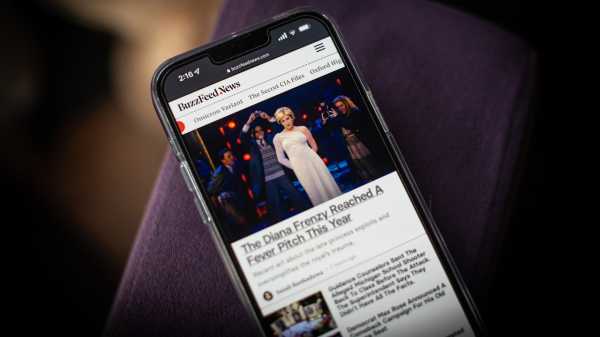
Three distinct crises unfolded online on Thursday, but in a sense all were part of the same story. One was the shutdown of BuzzFeed News, the journalism operation of the digital-content company, putting an end to a newsroom that launched in 2012, won a Pulitzer Prize in 2021, and at its peak employed around a hundred journalists. Another was the vanishing from Twitter of the majority of blue check marks, the tiny icons that verified the identities of celebrities and other public figures, including journalists. Elon Musk, who has gradually dismantled Twitter since taking the company over last October, had long promised that anyone who didn’t pay for a Twitter subscription would lose their check mark, which had come to represent a certain kind of insider Internet prestige. (Even Pope Francis’s Twitter account lost its blue sigil.) Lastly, an online audience of spectators looked on, in real time, as Musk’s SpaceX Starship, the most powerful rocket on Earth, exploded several minutes into its planned flight. The conflagration served as an apt symbol: everything was blowing up, and everyone could watch.
Just a decade ago, Twitter and BuzzFeed were the popular poles of a nascent social Internet. Twitter, where the hive mind of social media congregated, was faster and more fun than Facebook, more news-obsessed than the niche cultural fandoms of Tumblr. BuzzFeed was one of the first media companies to wholly embrace social media. Founded in 2006 by Jonah Peretti, who also co-founded the Huffington Post, it both observed online trends and memes and created them. The site constructed entire articles out of aggregating amusing tweets, and it pioneered digital personal quizzes in the vein of “Which Harry Potter Character Are You?” In 2011, Peretti brought on the journalist Ben Smith as its editor-in-chief. Though the site carried out investigative reporting on American election campaigns and international affairs, its most famous accomplishment might be a post about a photograph of a dress that looked either blue and black or white and gold depending on the viewer’s perception. It got more than twenty-eight million views in a day. Watching both Web sites crumble at once adds to an already burgeoning sense that a certain era of the Internet has ended, and that the rules under which they once thrived have fundamentally changed.
What that era was, exactly, is harder to define. So much of the previous decade of digital life was premised on the idea that user-generated content was an ideal: We as Internet denizens wanted to consume whatever was being published by other users like us, who were often people we knew as I.R.L. or online friends. Content was supposed to be free, the thinking went; the job of platforms was to provide a fire hose of tweets, Instagram photos, YouTube videos, and Facebook posts, which we would be left to navigate on our own. BuzzFeed made its business on curating the breadth of this user-generated content, highlighting and accelerating its most successful specimens, making social media seem like a fun place to be. (The company then leveraged its ability to handpick virality as a selling point to advertising clients.) Within the culture industries, BuzzFeed’s youthful energy and acumen became a subject of widespread jealousy. One infamous advice letter written in to the late, beloved blog the Awl began, “I hate myself because I can’t work for BuzzFeed.”
Ultimately, BuzzFeed relied on social media too much. Its news division lacked an independent business model, and its ability to grant virality was more conducive to revenue streams like Tasty, a food-content channel that now produces a line of cookware with Walmart. In a note to staff about the shutdown, Peretti wrote that he as the C.E.O. was to blame for being “slow to accept that the big platforms wouldn’t provide the distribution or financial support required to support premium, free journalism purpose-built for social media.” In other words, Facebook wasn’t going to make external content production profitable; why would it, when it had so many users willing to fill its feed for free and fuel the platform’s own advertising sales in turn?
Twitter survived because of its chaotic energy. Over time, Meta, the owner of Facebook and Instagram, turned away from news stories, particularly in the wake of the 2016 election, to focus on fostering social interactions and shopping opportunities. Twitter, meanwhile, remained a heated, relatively unfiltered arena for discourse. In 2020, the platform was an invigorating space for the Black Lives Matter movement, urging people out of pandemic isolation and into the streets for protests. Twitter was never the largest or most efficient social network, but it played an outsized role. Musk’s acquisition of the company last year, and his tumultuous attempt to reform it, has instead badly undermined that role. Musk gutted Twitter’s content-moderation staff, which once provided a safeguard against bots, misinformation, and hate speech. Before, Twitter was dysfunctional; now it hardly seems to function.
When the blue check marks disappeared this week, Twitter feeds seemed suddenly stripped naked: every account looked like every other one, except those which were willing to retain their verification by paying eight dollars a month. In the absence of verification, fake accounts immediately popped up for entities as varied as NYT Cooking and the I.R.S., a certain prelude to scams. Few accounts still have the blue checks, which now carry something of a stigma in the eyes of veteran users. Plenty of people are still tweeting, but the bad vibes are palpable. In a recent essay, the Times magazine editor Willy Staley described Twitter’s current atmosphere as “the part of the dinner party when only the serious drinkers remain.”
In hindsight, the twenty-tens saw the emergence, growth, dominance, and incipient decay of the largest social networks. All of us users have had the opportunity to learn the same lessons that Peretti did: that we can’t rely on massive digital platforms that are motivated by profit above all, that there is no guarantee they will protect or support us or work to deliver the best experiences possible. Instead, they will continue to encourage us to churn out content for free; they will work ruthlessly to capture our attention and then commodify it through every possible avenue. Those huge, public networks are growing riskier, messier, and less enticing by the day; the rocket that drove their explosive growth is faltering.
The next decade of the Internet is likely to yield more cloistered digital spaces that seek to correct the ills of Big Social Media. The looming “post-platform” era, as it is already being called, will consist of smaller online communities connecting through group texts, Reddit forums, Discord servers, and e-mail newsletters. It won’t run on public spectacle like the Web we’ve become accustomed to; virality may no longer be the goal. But it may at least offer a less exploitative mode of existing online. In a way, it will resemble an earlier version of the Internet, operating on a tried-and-true principle: friends are more trustworthy than strangers. ♦
Sourse: newyorker.com






